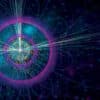A Window into New Physics
⇧ [VIDÉO] You may also like this partner content
In 2011, the Alpha Magnetic Spectrometer (AMS-02) was installed on the International Space Station (ISS) on an ambitious mission: to detect antimatter particles in cosmic rays. In late 2013, initial results revealed intriguing anomalies that challenged the knowledge established by the Standard Model of particle physics. In particular, AMS-02 recorded antihelium events, a particularly rare type of antimatter particle. These observations are all the more surprising because they indicate a detection frequency much higher than that predicted by the Standard Model, which assumes that the universe should contain a balance between matter and antimatter. A balance that, however, seems to be absent. In a new study, researchers propose a “cosmic fireball” hypothesis to explain the origin of the antiparticles detected on the ISS, paving the way for new physics.
Recently, a new study attempts to explain these intriguing observations. Previously, a separate study, led by Viviane Poulin of the University of Montpellier, examined the possible origins of the antihelium events detected by AMS-02. The analysis, available among others on arXiv Since 2018, it has been suggested that these events could originate from regions dominated by antimatter, such as anticlouds or antistars.
Cosmic fireball hypothesis
As part of the new study, published June 21, 2024 in the journal Physical review dThe main hypothesis that researchers have put forward to explain these observations is the theory of cosmic fireballs. These hypothetical phenomena would be the result of extremely energetic collisions of dark matter, a mysterious substance that makes up about 27% of the universe. During these collisions, extremely dense and energetic regions would form, where antiparticles such as antihelium could be produced in abundance.
” Once formed, these fireballs expand at nearly the speed of light, releasing antiprotons, antineutrons, and antihelium into the surrounding environment. “It explains to Life Science Anubhav Mathur, PhD student at Johns Hopkins University.
In the new study, the researchers used modern semi-analytical tools to model cosmic fireballs. The results indeed suggest that these phenomena can produce large amounts of antimatter, including antihelium-4. Simply put, a cosmic fireball is an extremely dense and energetic region. As these fireballs become optically thin, they release different nuclei of antimatter, the researchers explained in the study.
Simulations show that the proportions of these nuclei are consistent with the AMS-02 observations. For example, the abundance of antihelium-4 follows a predictable hierarchy, consistent with the initial conditions of the fireball. Numerical results indicate that the abundance of antihelium-4 nuclei is consistent with the AMS-02 observations, strengthening the hypothesis that these phenomena could be the origin of the AMS-02 detections.
implications of particle physics
The implications of this discovery may require a fundamental revision of the Standard Model of particle physics. The AMS-02 results, combined with future discoveries from complementary missions such as GAPS, could open up new avenues of research.
To confirm these discoveries, additional missions are in the works. The General Antiparticle Spectrometer Project (Gaps) plans to launch a balloon over Antarctica to detect antimatter cosmic rays. This mission could provide additional data essential to verifying or disproving the cosmic fireball hypothesis.
See also

Meanwhile, physicists continue to analyze data from AMS-02. We look forward to AMS-02 completing the analysis of candidate helium events, and obtaining additional data in the future that may shed more light on this mystery. “I announced to
Trust my knowledge Michael A. Federke, study co-author and postdoctoral researcher at the Perimeter Institute for Theoretical Physics in Canada.
Regardless, the initial results are promising, but further observations and analysis are needed to confirm these results and understand their significance. The detection of antihelium on the ISS may be the first evidence of previously unknown physics.
